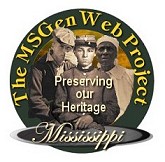
Pontotoc County, Mississippi
Genealogy and History
Peggy A. Young, County CoordinatorJeff Kemp - State Coordinator Denise Wells - Assistant State Coordinator
Ann Allen Geoghegan - Assistant State Coordinator
Sunday, 13-Jun-2010 13:43:55 EDT

W. P. A. History of Pontotoc County,
Mississippi
CHAPTER 1 CONTINUED
Old Settlements
WOODLAND community, another of the older communities in the county, about 10 miles southeast of Pontotoc, was settled in 1831. The first real settler in this neighborhood was Jerry Mier Stegalll, with his wife and three children. He built a log hut for his family in the dense forest in the midst of Indians and wild animals. There was wild game of all kinds, the woods were full of bees, and a corn patch furnished bread. There was plenty of food with honey for desert. Later, as other settlers came, the families began to raise wheat. There were only two houses between the Stegall place and Pontotoc. Soon other families from the eastern states came and settled, clearing the land and building log huts. These latest settlers brought Negro slaves, the first in the community. As the community grew, sawmills of an ancient type and cotton gins were introduced and churches and schools established.
In the homes were spinning wheels and looms. Women made clothes for their families; the clothes were very simple, plain cotton dresses and woven wool shawls. When dry goods stores were open the women began to wear calico dresses, which were considered very elegant. These dresses were made with tight waists and full skirts under which was worn hoop skirts made of wire wrapped with cloth. Shoes for the family were made principally from cow hides; for finer wear calf skins were used. These were called kid shoes.
Children went barefoot until they were nearly grown. The shoes were blackened with soot and grease. Women were rarely seen with hats; they wore homemade sunbonnets to church and all other places. Everybody worked during the week; on Friday nights there would occasionally be a party for the younger set, the principal amusement at these parties was the "square dance", with "fiddle" music. Slaves dressed up on Christmas Eve and gave a dance which they called a "Holliday". (1)
(1) Mrs. Ella Cooper, Pioneer, Woodland Community
Back Contents Next